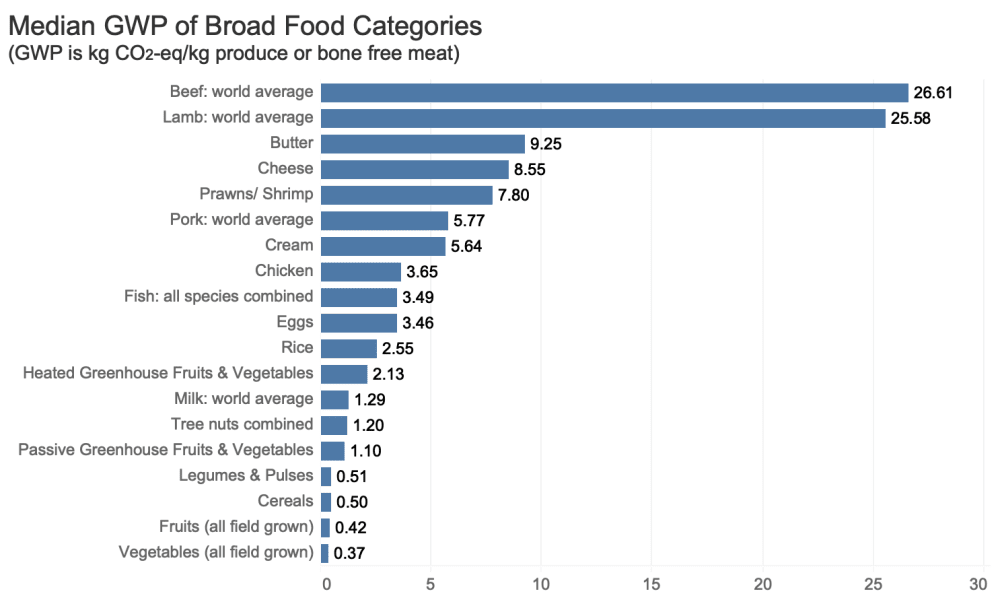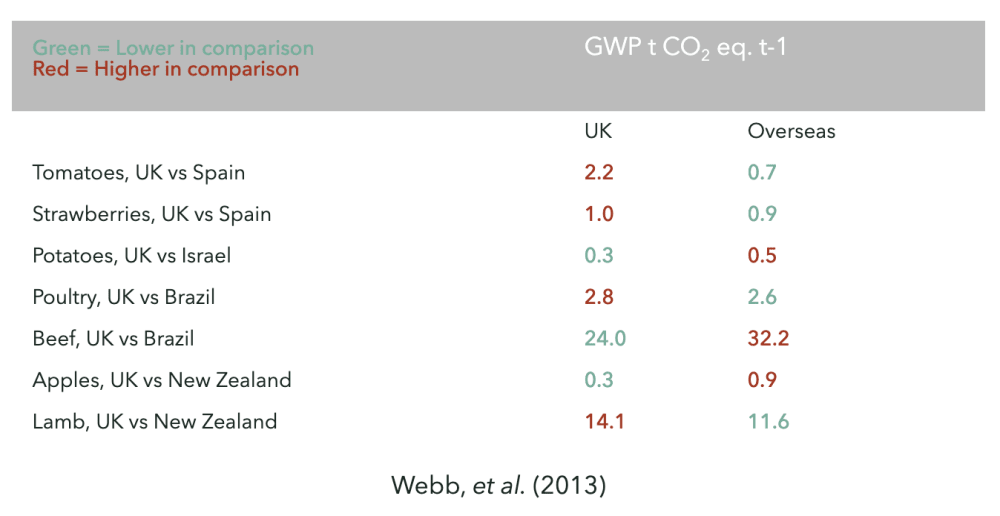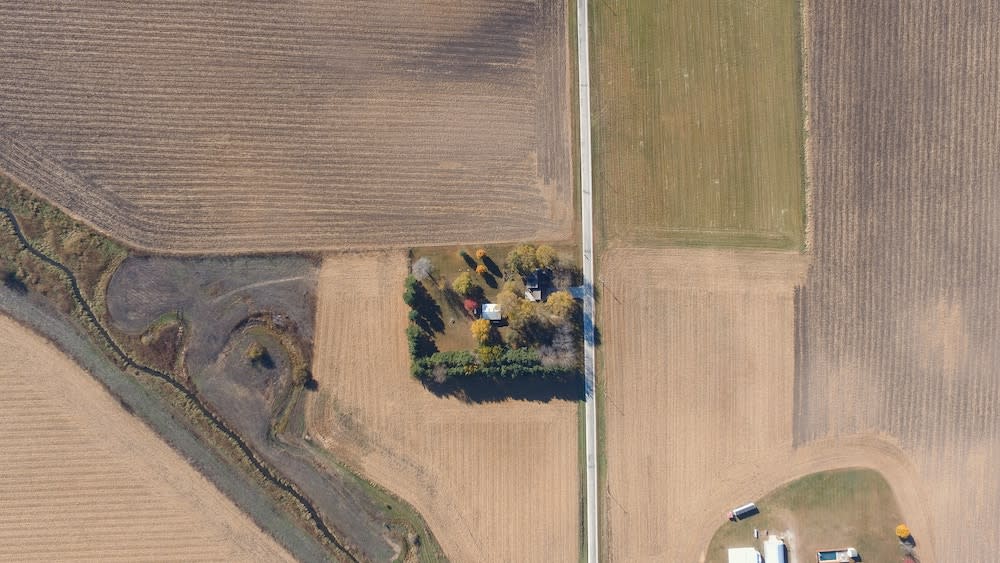Lately, we’ve heard a lot about how cutting back on our meat consumption can help the environment. But what does this mean?
This article looks at our food consumption from an environmental point of view. Refer to our article on ultra-processed foods if you are interested in the latest health perspective.
We recently read an interesting article by Jo Clay on Australian ABC News. Clay tracked the carbon footprint of what she ate over an entire year, with the aim of reducing it by a different method every week.
How do we even begin to count our carbon footprint? Wouldn’t it be nice if carbon emissions were listed right alongside an item’s ingredient list and calorie count? How would that even happen?
It all starts with research studies, and the amount of cumulative work that goes into them is staggering.
Lots and lots of studies – and yet not enough
Consider this study.1 It is a review and summary of 369 other studies on 168 varieties of fresh produce. Yet there are a good number of important food types yet to be included in any published study.
Researchers in each study have done their own research on global warming potential (GWP), which considers any activity undertaken in the food process that involves the use of fossil fuels involved in heating, transport and industrial processing. And each study considers slightly different conditions, depending on which data is available.
For agriculture, the rabbit hole is deep.
The production (fertilisers, feed, land use, by-products), transport, processing, packaging, marketing, sales, purchasing and cooking of the food must be considered and then proportioned accordingly.
For proportioning, we should consider all outputs and then split the impact. For example, beef is produced from an animal that also provides leather and other by-products, so carbon emissions should be divided between them all. Cows by the kilo must be adjusted for the parts that are not eaten in order to compare with other foods by the kilo.
The resulting GWP figures are estimates for comparing how much environmental impact a food has.
 Source: Clune, S, Crossin, E & Verghese, K (2017). Systematic review of greenhouse gas emissions for different fresh food categories. Journal of Cleaner Production, 140, 766–783.
Source: Clune, S, Crossin, E & Verghese, K (2017). Systematic review of greenhouse gas emissions for different fresh food categories. Journal of Cleaner Production, 140, 766–783.GWP is a rather technical and abstract measurement. It compares the global warming impacts of different gases compared to carbon dioxide. The larger the GWP, the more a given gas warms the earth compared to CO2 over a specific time period (usually 100 years). For example, methane (CH4) has a shorter lifespan than CO2, but it absorbs a much greater amount of energy and so has a high GWP of 28–36 over 100 years (i.e., roughly 30 times the environmental damage of CO2).
The GWP figures above do not include cooking, air freight or canning. There are studies that go deeper 2, calculating typical family diet figures and even adjusting for the increased amount of food you would eat of one type (legumes, for example) if you were to reduce eating another type (i.e., meat).
Location matters
The geographic location of where a food item is produced does affect the resulting GWP value, and local is not always best.
Milk is the most studied of all food products, with 262 separate GWP values. The results of each of these studies vary predictably, with Australia and New Zealand figures showing half the GWP of those based in Asia and Africa.
This fantastic e-book by foodsource.org.uk references this study in Section 3.3.4. Using GWP for different modes of transport per distance travelled and any refrigeration or special packaging required for transport versus the GWP for growing locally, researchers have been able to determine that lettuce grown indoors in the UK during winter has a higher GWP than field-grown Spanish lettuce transported to the UK. In summer, when lettuce is grown outdoors in the UK, it is better to buy local.
 Local vs overseas GWP of various food types. Source: foodsource.org.uk
Local vs overseas GWP of various food types. Source: foodsource.org.ukAnytime there is transport by plane, the carbon footprint of transport becomes very significant. This leaves us in Hong Kong with a clear choice to make if we want to reduce our impact even if our local options are sometimes very limited. Air-fresh produce is an oxymoron.
 Photo credit: Mladen Borisov on Unsplash
Photo credit: Mladen Borisov on UnsplashThe GWP of beef varies greatly depending on where it comes from and how it is grown. Interestingly, White Oak Pastures believe regenerative grazing and storing carbon in the soil to offset emissions result in a negative carbon footprint.
Recording the matrix of variables
There is a tremendously complex matrix of factors involved at every step of food production, and there is no standard way of measuring most of them.
At our our Food’s Future Summit last year, we considered applying blockchain (or distributed ledger technology) to the food production and supply chains in order to record some of these factors.
One company applying this technology right now is Italy’s Devoleum. They are tracking olives, from harvesting to sale on the market (see a simulated history here).
With this framework in place, we should be able to store a great deal of data in a transparent manner – for example, how much water/pesticides/fertiliser has been added to a section of crops or what was fed to an animal over its lifetime including any medicines.
However, to store this much data on blockchain can be computationally expensive and not all blockchains are suitable. One study has found that Bitcoin consumes 22 megatons of CO2 emissions in a year – as much electricity as the whole of Las Vegas. Supply-chain blockchains may be based on Ethereum, which uses a less energy-consuming method of confirming data writing, but the energy consumed may still be significant.
Hyperledger is another blockchain solution that uses permissioned access and a pluggable consensus algorithm and so has no need of electricity hungry mining.
Putting this information into a good old-fashioned database is certainly a fine option if we are able to enable access from anywhere in the supply chain. Whenever there is centralised control, the controlling party has the power to change the data stored, but there are ways to ensure that the data has not been tampered with.
How would we record all this data?
Smart farming, or precision farming, is the implementation of IoT (Internet of Things) in order to automate and improve yields based on data collected and analysed automatically. The first step in smart farming is observation – sensors that monitor things such as soil, water, light, humidity and temperature. There are even sensors to detect pests, and drones and satellites are already in use already to monitor crops.
 Photo credit: Ryan Spencer on Unsplash
Photo credit: Ryan Spencer on UnsplashPrecision farming uses current technologies to increase the quantity and quality of products while optimising (and reducing) human labour. With this as a financial incentive, the collection of this data may not be as big a hurdle as we think.
Sharing the data
There would be a tremendous amount of new data, and we currently have no globally accepted standard by which the data is described and recorded in order to share, exchange and understand it, no matter the platform. Without global standards, if may be difficult to interpret the data (similar to the many different adapters needed to charge your various devices each day).
Once we have the recorded growing, packaging and transport conditions, it is trivial to apply the appropriate formulae to determine the carbon emissions of a food item, and we would have a record of exactly where and how this food made it into our hands. Accountability and traceability (proof of provenance) from blockchain is already in use in the Australian beef industry.
Private companies are pursuing this technology owing to the premium put on trust of authentic goods. Unfortunately, displaying the carbon emissions of a product carry no such financial incentive.
Join us at our upcoming Food’s Future Summit 2019 in October to find out more.
1 Clune, S, Crossin, E & Verghese, K (2017). Systematic review of greenhouse gas emissions for different fresh food categories. Journal of Cleaner Production, 140, 766–783.
2 Berners-Lee, M, Hoolohan, C, Cammack, H & Hewitt, C (2012). The relative greenhouse gas impacts of realistic dietary choices. Energy Policy, 43, 184–190.













